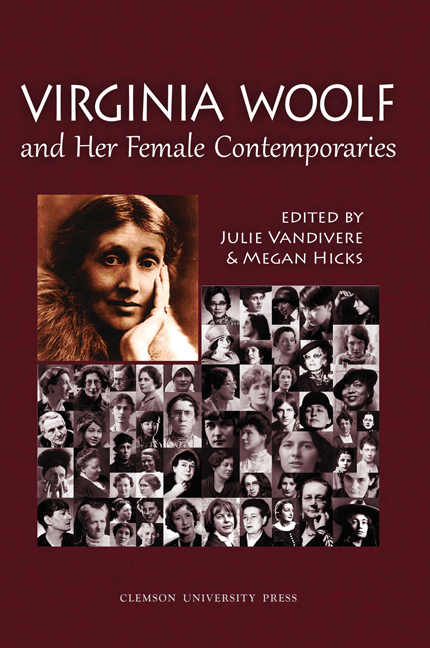Book contents
- Frontmatter
- Table of Contents
- Introduction
- Acknowledgments
- Abbreviations
- Who Are Virginia Woolf's Female Contemporaries?
- Virginia Woolf's Cultural Contexts
- Virginia Woolf's Contemporaries Abroad
- Virginia Woolf's Contemporaries at Home
- “The Squeak of a Hinge”: Hinging and Swinging in Woolf and Mansfield
- “People must marry”: Queer Temporality in Virginia Woolf and Katherine Mansfield
- The Weight of “Formal Obstructions” and Punctuation in Mrs. Dalloway and Pointed Roofs
- Advise and Reject: Virginia Woolf, the Hogarth Press, and a Forgotten Woman's Voice
- Florence Melian Stawell and Virginia Woolf: Home-front Experience, The Price of Freedom, and Patriotism
- Intimations of Cosmic Indifference in Virginia Woolf 's Orlando and Olive Moore's Spleen
- “Could I sue a dead person?”: Rebecca West and Virginia Woolf
- Splintered Sexualities in Rebecca West's The Return of the Soldier, Virginia Woolf 's Mrs Dalloway, and Sylvia Townsend Warner's “A Love Match”
- Sexual Cryptographies and War in Virginia Woolf 's Between the Acts and Elizabeth Bowen's The Heat of the Day
- Tribute to Jane Marcus
- Notes on Contributors
- Conference Program 223
“The Squeak of a Hinge”: Hinging and Swinging in Woolf and Mansfield
from Virginia Woolf's Contemporaries at Home
- Frontmatter
- Table of Contents
- Introduction
- Acknowledgments
- Abbreviations
- Who Are Virginia Woolf's Female Contemporaries?
- Virginia Woolf's Cultural Contexts
- Virginia Woolf's Contemporaries Abroad
- Virginia Woolf's Contemporaries at Home
- “The Squeak of a Hinge”: Hinging and Swinging in Woolf and Mansfield
- “People must marry”: Queer Temporality in Virginia Woolf and Katherine Mansfield
- The Weight of “Formal Obstructions” and Punctuation in Mrs. Dalloway and Pointed Roofs
- Advise and Reject: Virginia Woolf, the Hogarth Press, and a Forgotten Woman's Voice
- Florence Melian Stawell and Virginia Woolf: Home-front Experience, The Price of Freedom, and Patriotism
- Intimations of Cosmic Indifference in Virginia Woolf 's Orlando and Olive Moore's Spleen
- “Could I sue a dead person?”: Rebecca West and Virginia Woolf
- Splintered Sexualities in Rebecca West's The Return of the Soldier, Virginia Woolf 's Mrs Dalloway, and Sylvia Townsend Warner's “A Love Match”
- Sexual Cryptographies and War in Virginia Woolf 's Between the Acts and Elizabeth Bowen's The Heat of the Day
- Tribute to Jane Marcus
- Notes on Contributors
- Conference Program 223
Summary
As a locus of energy, propulsion, and thrust, the hinge is used metaphorically by Virginia Woolf and Katherine Mansfield to suggest freedom and movement in space, time, class, and gender. Instances of hinge instability, including seasonal, meteorological, cultural, postural, and psychological, are present in their works. Jane Goldman writes that the squeak of the hinges at the start of Mrs. Dalloway (1925) “echoed throughout modernist narrative” (69). Mansfield's earlier stories might have been resonating for Woolf. She was rereading her contemporary's work at the end of June 1923, while working on Mrs. Dalloway (MD xiii).
As a structural metaphor, the hinge relates to a variety of concepts: axels, still points, rotation, leverage, oscillation, transition, and translation. The usual French translation for hinge in Mrs. Dalloway is gonds, which implies a literal, mechanical, articulating fulcrum or pivot point. The Portuguese translation is gonzo, which brings to mind the outrageously subjective, digressive, freewheeling journalism of Hunter S. Thompson. Italian translations of Mrs. Dalloway use cardine for hinge, and this shares its stem with the English word “cardinal,” meaning of paramount importance.
In his structural analysis of narrative, Roland Barthes writes about the application of cardinal functions. He uses a different word—charnière—rather than gonds to describe these functions. Charnière has the metaphorical implication of a turning point, a veering off into new narrative space. Cardinal functions are, for Barthes, “real hinge-points of the narrative” (93). For a function to be cardinal, it should “open (or continue, or close) an alternative that is of direct consequence for the subsequent development of the story, in short that it inaugurate or conclude an uncertainty” (93–94). Inconveniently though, modernist narratives are frequently left uncertain, without conclusion. Readers will differ in their subjective judgement about hinge points in modernist works. Identifying a cardinal function is extremely useful in adaptation studies and for the analysis of conventionally plotted novels, but is less helpful for undecidable texts. Thresholds occur as places of tension where characters are turning over decisions in their minds, testing concepts, reflecting on experience. Joyce's epiphanies, Woolf's “moments of being,” Mansfield's “blazing’ moments” are uncertain, ambiguous, often contradictory. Modernist texts play with focalisation through free direct and indirect discourse, eschewing the authority of a single perspective.
- Type
- Chapter
- Information
- Virginia Woolf and Her Female Contemporaries , pp. 150 - 156Publisher: Liverpool University PressPrint publication year: 2016



